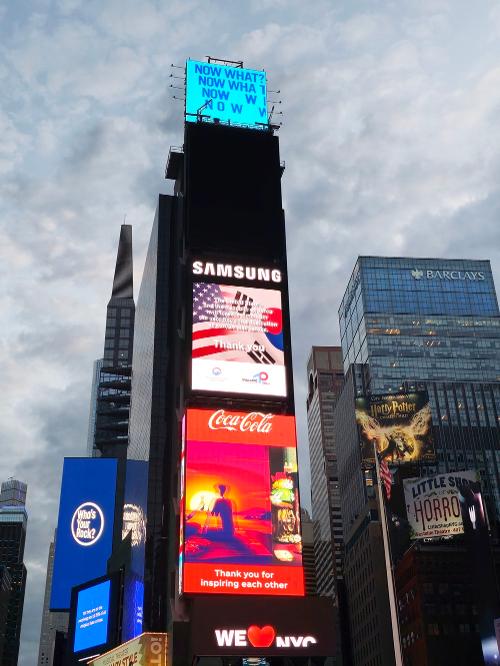
A video of 10 Korean War veterans jointly produced by the Ministry of Patriots and Veterans Affairs and the Republic of Korea-U.S. Combined Forces Command on April 20 is screened on the electronic billboards of Samsung Electronics and LG Corp. at New York's Time Square. (Ministry of Patriots and Veterans Affairs)
By Lee Jihae
Video = Ministry of Patriots and Veterans Affairs
A video of 10 Korean War veterans is appearing on giant electronic screens at New York's Times Square for two weeks.
The Ministry of Patriots and Veterans Affairs said it jointly selected the 10 from both the Republic of Korea (ROK) and U.S. and made a video with the ROK−U.S. Combined Forces Command to begin screening on April 20 at Times Square.
The video remembers and thanks veterans from both countries including the 10 and conveys the intent to continue the strong alliance between Seoul and Washington, the ministry added.
The 30-second video is being screened 680 times daily on the electronic billboards of Samsung Electronics and LG Corp. for two weeks at Times Square.
The 10 veterans are Gen. Douglas MacArthur, supreme commander for the Allied Powers; Gen. James Alward Van Fleet and his son, Air Force Capt. James Alward Van Fleet Jr; military chaplain William Earl Shaw and his son, Navy Lt. William Hamilton Shaw; Air Force Col. Dean Elmer Hess; Army Col. Ralph Puckett Jr; and Army Col. Kim Young-oak on the American side and Gen. Paik Sun-yup; Air Force Gen. Kim Doo-man; Army Col. Kim Dong-seok and Marine Col. Park Jung-mo on the ROK side.
As head of United Nations forces, Gen. MacArthur turned the tide of the war by leading the famous Incheon landing on Sept. 15, 1950, and saved the Republic of Korea. He successfully led the amphibious assault despite difficulties such as large tidal swings and U.S. opposition.
Gen. Van Fleet and his son both fought in the Korean War. The elder Van Fleet as commander of the 8th U.S. Army never gave up when told by his staff that the war was "hopeless" and to retreat to Tokyo, instead continuing to protect the front lines.
His son was a fighter pilot in the conflict and went missing in action (MIA) in April 1952 after being hit by enemy anti-aircraft fire during a mission. His father suspended the search for his son's body to avoid sacrificing more Allied forces, and James Jr. remains MIA.
Shaw and his son were also two generations of a family who fought in the war. The elder Shaw was a missionary who enlisted as a chaplain to the U.S. Army in South Korea and introduced the chaplain system to the Korean military.
His son reentered the U.S. Navy after serving in World War II when the Korean War broke out, leaving his doctoral program at Harvard University. The junior Shaw was killed at age 28 by an enemy bullet while on a reconnaissance mission to recapture Seoul.
On Jan. 4, 1951, Hess evacuated 950 war orphans and nursery staff when U.S. and ROK forces retreated from the advancing Chinese army and safely took them to Jeju Island.
Puckett Jr. in November 1950 led the capture of Hill 205, a strategic point north of the Cheongcheongang River despite being hit by a grenade during the mission. He is remembered for ordering his men to leave without him while unable to move because of severe injuries so that they could evacuate safely.
Kim Young-oak was a Korean American who also fought in World War II. In the Korean War, he took part in May 1951 in the battle of Gumansan Mountain and Tapgol and that of Geumbyeongsan Mountain, where he encouraged his low-morale unit and led it to victory. In 2018, he became the first ethnic Korean to have a highway named after him in the U.S.: Kim Young Oak Memorial Highway in California.
Paik led the ROK Army's 1st Division during the war at the Battle of Dabudong and annihilated three North Korean divisions with the help of American forces. He told his men "Shoot me if I retreat" and practiced the soldier's spirit of never quitting on the battlefield.
Kim Dong-seok was in charge of information and communications for the 8th U.S. Army. He collected and provided pivotal information about the enemy to the United Nations Command and greatly contributed to the Allied recapture of Seoul.
During the recapture of Seoul, Park led his platoon during combat on the streets, removed the North Korean flag from the government building and raised the ROK flag.
"We consider it highly meaningful to select 10 Korean War veterans from Korea and the U.S. on the 70th anniversary of the Armistice Agreement and ROK-U.S. alliance," Minister of Patriots and Veterans Affairs Park Minshik said.
"We will remember and never forget the great sacrifice and dedication of veterans including these 10 heroes who gave their lives to protect the Republic of Korea's liberal democracy, which was struck by crisis about 70 years ago, that laid the foundation of the strong Korea-U.S. alliance."
jihlee08@korea.kr